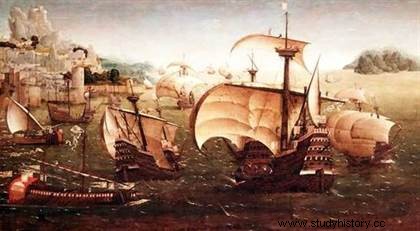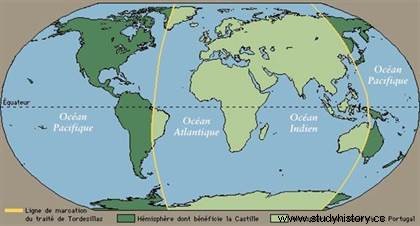 Signed on June 7, 1494, the Treaty of Tordesillas establishes an imaginary demarcation line crossing the Atlantic west of the Cape Verde Islands and delimits the overseas possessions of Spain and Portugal. By this treaty, which will be ratified by a papal bull, the Catholic Kings and John II of Portugal share the still unexplored New World. The other European maritime powers are denied any right to these new lands. François I will ask to see "the clause of Adam's will which excludes him from this division". The Amerindian, African and Asian populations are not consulted during the negotiation of Tordesillas...
Signed on June 7, 1494, the Treaty of Tordesillas establishes an imaginary demarcation line crossing the Atlantic west of the Cape Verde Islands and delimits the overseas possessions of Spain and Portugal. By this treaty, which will be ratified by a papal bull, the Catholic Kings and John II of Portugal share the still unexplored New World. The other European maritime powers are denied any right to these new lands. François I will ask to see "the clause of Adam's will which excludes him from this division". The Amerindian, African and Asian populations are not consulted during the negotiation of Tordesillas...
Spain and Portugal share the world
From the middle of the 15th century, Portugal set out on the Atlantic Ocean, in search of a new trade route to Asia, and set up trading posts along the African coasts. The passage of the Cape of Good Hope, gateway to the Indian Ocean, by the Portuguese expedition of Bartolomeu Dias in 1488 opens the way to Asia. But quickly, Portugal entered into competition with the rising power in Europe, Spain. In the years 1480-1490, Portugal was forced to cede its territorial claims to the Canary Islands for the benefit of Isabella the Catholic, which would be formalized by the Treaty of Alcáçovas concluded in 1479.
 It is above all the discovery of the Americas by Christopher Columbus that makes the establishment of a dividing line urgent areas of influence between the two countries of the Iberian Peninsula. In 1493, a first bull from Pope Alexander VI fixed the line of "marking" from pole to pole at 100 leagues west of the Cape Verde Islands. It is a success for the Spaniards, but the King of Portugal asks the following year that this dividing line be renegotiated. The discussions began in May 1493 in Tordesillas, in the province of Valladolid.
It is above all the discovery of the Americas by Christopher Columbus that makes the establishment of a dividing line urgent areas of influence between the two countries of the Iberian Peninsula. In 1493, a first bull from Pope Alexander VI fixed the line of "marking" from pole to pole at 100 leagues west of the Cape Verde Islands. It is a success for the Spaniards, but the King of Portugal asks the following year that this dividing line be renegotiated. The discussions began in May 1493 in Tordesillas, in the province of Valladolid.
The Treaty of Tordesillas
By the Treaty of Tordesillas, signed on June 7, 1494 between the Catholic Kings and John II of Portugal, Spain and Portugal fixed the line of demarcation of their future possessions besides -sea:this line, which Pope Alexander VI had fixed in 1493 at 100 leagues west of the Azores and Cape Verde, was postponed, at the request of the Portuguese, to 370 leagues. Any land discovered east of this line was to belong to Portugal; to the West, to Spain. The Treaty of Tordesillas was confirmed by Pope Julius II in 1506 (Bulle Inter Caetera). From now on, all lands subsequently discovered to the east of said line will be Portuguese and any territory to the west will belong to the Spanish crown.
 The treaty reserves Portugal's most coveted trade routes, those that lead to the precious spices of the Orient , establishing counters along the African coasts and in Asia. The rectification of Tordillas gives Portugal rights to the American continent, where the small Iberian kingdom will establish its only settlement, Brazil.
The treaty reserves Portugal's most coveted trade routes, those that lead to the precious spices of the Orient , establishing counters along the African coasts and in Asia. The rectification of Tordillas gives Portugal rights to the American continent, where the small Iberian kingdom will establish its only settlement, Brazil.
For its part, Spain will be able to build an immense empire from Mexico and Peru and will rise to the rank of first European power. The silver and gold flowing in from America will allow him to finance his wars in Europe while stimulating the economy of the old continent. Around 1550, Spain controlled almost the entire South American continent, Central America, Florida, Cuba and, in Asia, the Philippines.
A quickly contested treaty
As early as the 16th century, cuts were made by both nations in the Treaty of Tordesillas. The Portuguese colony of Brazil will extend well beyond the line of demarcation, and in Asia Spain seizes the Philippines and Ternate, however in the Portuguese sphere. The line of demarcation and all the agreements connected with it were abolished in 1750 by a treaty settling a dispute over the southwestern border of Brazil. The 1750 treaty was in turn repealed in 1761. Further disagreements between the two countries were settled by another treaty in 1779.
The maritime nations of northern Europe (England, France and the Netherlands) gave little value to the various treaties that Spain signed with the papacy and the Portugal and, from 1520, their merchant ships entered the Caribbean Sea with increasing frequency, supplying the large islands with African slaves. In the 17th century, declining Portugal and Spain could only watch helplessly as new colonial empires emerged in their areas of influence delineated by the Treaty of Tordesillas.
Bibliography
- NEBENZAHL Kenneth, Atlas of Christopher Columbus and the Great Discoveries, Bordas, 1993.
- LEBRUN François, Europe and the world, A. Colin, 2008 (5th ed.).
- MEYER Jean, Europe and the conquest of the world:XVIth-XVIIIth century, A. Colin, 2009 (3rd ed.), 367p.
The Treaty of Tordesillas (1494):the division of the world (animated map)
